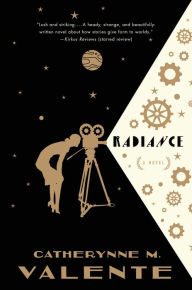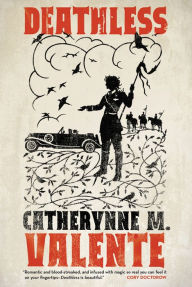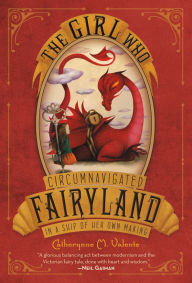In Radiance, Catherynne M. Valente Scripts an Unforgettable Interstellar Tale
 In Radiance, Catherynne M. Valente has not written a mystery novel, despite the missing protagonist, the noirish detective, and even the accusations of murder. A mystery novel presents to you a known outcome from which you deduce, theorize, and postulate unknown events. There is a central enigma to solve, and you, the audience, know what it is. A dead body. A smoking gun. A roster of suspects.
In Radiance, Catherynne M. Valente has not written a mystery novel, despite the missing protagonist, the noirish detective, and even the accusations of murder. A mystery novel presents to you a known outcome from which you deduce, theorize, and postulate unknown events. There is a central enigma to solve, and you, the audience, know what it is. A dead body. A smoking gun. A roster of suspects.
Radiance is hardly that straightforward, peppering you with diary extracts, film snippets, interview transcripts, gossip columns, and anonymous asides that eventually fill you in on the mystery Valente wishes to reveal to you, piece by piece. It’s interstellar decopunk gothic noir, wrapped in a celluloid bow.
Radiance
Radiance
Hardcover $24.99
Dropped into this swirling, celestial narrative is Severin Unck, a filmmaker’s daughter and a documentarian in her own right, born on the Moon, simultaneously ill-suited and perfectly fitted to a life examined constantly through a lens. Severin’s epoch is the Golden Age of movie-making, but in this world, humanity is far from tethered to Earth, colonizing the known planets and moons—but not the planets and moons you learned about in school. This solar system is teeming with life; you can swim with the callowhales in the seas on Venus, and watch the universe pass you by from a homestead on distant Uranus. It’s a Grand Tour by way of an earlier age of imagination, when science had yet to dull the sense of possibility Out There.
Instead of Hollywood, Tinsel Town is located on Earth’s moon, and Percival Unck, Severin’s father and a worlds-class filmmaker, is its undisputed king. His meticulous filming and archiving of Severin’s childhood provides snapshots of her existence, and these personal reels both reveal and complicate the matter at hand: just which mystery are we trying to solve? The one about Severin’s real mother? The one about the mysterious child she stumbled upon while filming on Venus? The one about her disappearance on that same ill-fated shoot?
Dropped into this swirling, celestial narrative is Severin Unck, a filmmaker’s daughter and a documentarian in her own right, born on the Moon, simultaneously ill-suited and perfectly fitted to a life examined constantly through a lens. Severin’s epoch is the Golden Age of movie-making, but in this world, humanity is far from tethered to Earth, colonizing the known planets and moons—but not the planets and moons you learned about in school. This solar system is teeming with life; you can swim with the callowhales in the seas on Venus, and watch the universe pass you by from a homestead on distant Uranus. It’s a Grand Tour by way of an earlier age of imagination, when science had yet to dull the sense of possibility Out There.
Instead of Hollywood, Tinsel Town is located on Earth’s moon, and Percival Unck, Severin’s father and a worlds-class filmmaker, is its undisputed king. His meticulous filming and archiving of Severin’s childhood provides snapshots of her existence, and these personal reels both reveal and complicate the matter at hand: just which mystery are we trying to solve? The one about Severin’s real mother? The one about the mysterious child she stumbled upon while filming on Venus? The one about her disappearance on that same ill-fated shoot?
Deathless
Deathless
In Stock Online
Paperback $18.99
The answer, of course, is a little bit of all of them. To unwrap the package, however, we must rip off the celluloid bow. The filmmaking daughter of a prolific director, whose parade of starlet wives provides a whirlwind, glamorous childhood picture, goes missing—on camera—while shooting her latest documentary on Venus. Before her disappearance, she and her crew find an orphaned child with a grotesque physical ailment and a deeper history with Severin than initially revealed.
The currency of this book, even more than the starlit setting, is film. Everything about the experience is mediated. When we’re alongside Anchises St. John, the child Severin discovered, we’re never quite sure if it’s him—his real self—or the cinematic persona created for him by Percy Unck, a grieving father trying to get the narrative of his daughter’s existence finally right.
Severin’s story—and her life is a story, ever since her father filmed and refilmed the finding of her in a basket on his doorstep as an infant—has a multitude of beginnings and endings, a hundred entry points revealed to us through scraps, real and fictional, from her childhood to her post-existence, the mysterious fate after her camera stopped rolling.
“How many beginnings can a story have, Daddy?” a young Severin asks. “As many as you can eat, my lamb. But only one ending,” Percy replies. “Or maybe it’s the other way around: one beginning, but a whole Easter basket of endings.”
The answer, of course, is a little bit of all of them. To unwrap the package, however, we must rip off the celluloid bow. The filmmaking daughter of a prolific director, whose parade of starlet wives provides a whirlwind, glamorous childhood picture, goes missing—on camera—while shooting her latest documentary on Venus. Before her disappearance, she and her crew find an orphaned child with a grotesque physical ailment and a deeper history with Severin than initially revealed.
The currency of this book, even more than the starlit setting, is film. Everything about the experience is mediated. When we’re alongside Anchises St. John, the child Severin discovered, we’re never quite sure if it’s him—his real self—or the cinematic persona created for him by Percy Unck, a grieving father trying to get the narrative of his daughter’s existence finally right.
Severin’s story—and her life is a story, ever since her father filmed and refilmed the finding of her in a basket on his doorstep as an infant—has a multitude of beginnings and endings, a hundred entry points revealed to us through scraps, real and fictional, from her childhood to her post-existence, the mysterious fate after her camera stopped rolling.
“How many beginnings can a story have, Daddy?” a young Severin asks. “As many as you can eat, my lamb. But only one ending,” Percy replies. “Or maybe it’s the other way around: one beginning, but a whole Easter basket of endings.”
The Girl Who Circumnavigated Fairyland in a Ship of Her Own Making (Fairyland Series #1)
The Girl Who Circumnavigated Fairyland in a Ship of Her Own Making (Fairyland Series #1)
By
Catherynne M. Valente
Illustrator
Ana Juan
In Stock Online
Paperback $11.99
Valente provides all of the above, within an elegant torch song of a novel. Just as she’s done in Deathless, her Fairyland series, and the rest of her canon, she weaves together mythos and fantasy, and paints pictures with her poetic prose (“Snow piled up like bodies in the street” in a gritty detective chapter), with never a word wasted.
It’s a style that fits Severin, who never had much patience for her father’s on-camera make-believe. She saw the entrancing nature of reality instead, and she left home to tell its tale. This is a story about movies, and planets, and down-on-their-lucks and stars (of both kinds), and risk and reward. But it’s primarily a story about stories, and about how the world is built on them and of them. As we delve into the mysteries of Severin’s life and possible death, we come to realize she too was a story—but one worth the telling.
“Without an audience, it doesn’t exist,” an acquaintance tells Anchises. “If a movie shows in the theatre and there’s no one there to see it, does it make a sound?”
Thankfully, this show has an audience, and you’ll be humming its melody for a long time to come.
Valente provides all of the above, within an elegant torch song of a novel. Just as she’s done in Deathless, her Fairyland series, and the rest of her canon, she weaves together mythos and fantasy, and paints pictures with her poetic prose (“Snow piled up like bodies in the street” in a gritty detective chapter), with never a word wasted.
It’s a style that fits Severin, who never had much patience for her father’s on-camera make-believe. She saw the entrancing nature of reality instead, and she left home to tell its tale. This is a story about movies, and planets, and down-on-their-lucks and stars (of both kinds), and risk and reward. But it’s primarily a story about stories, and about how the world is built on them and of them. As we delve into the mysteries of Severin’s life and possible death, we come to realize she too was a story—but one worth the telling.
“Without an audience, it doesn’t exist,” an acquaintance tells Anchises. “If a movie shows in the theatre and there’s no one there to see it, does it make a sound?”
Thankfully, this show has an audience, and you’ll be humming its melody for a long time to come.


